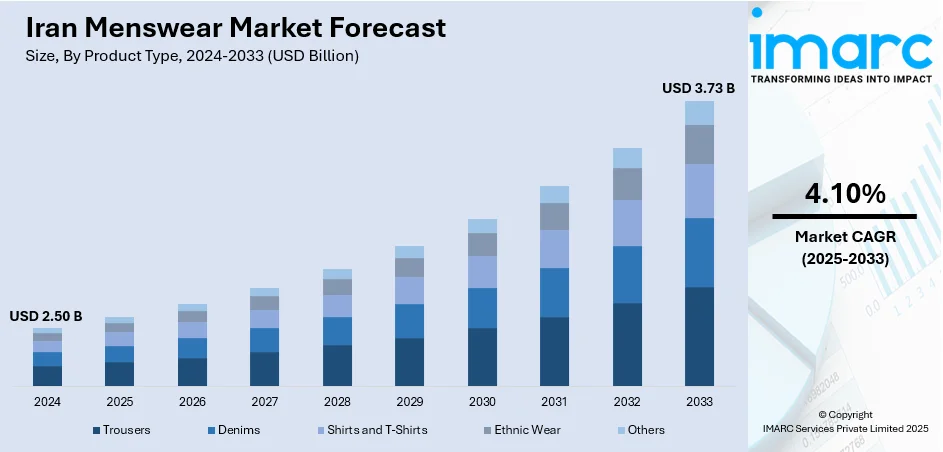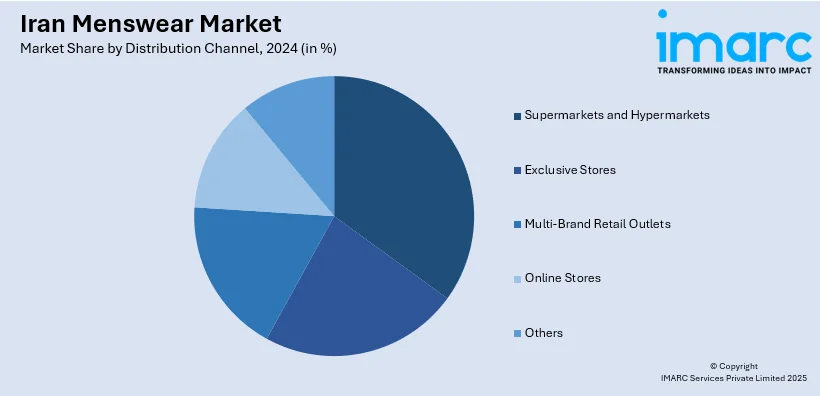
Iran Menswear Market Size, Share, Trends and Forecast by Product Type, Season, Distribution Channel, and Region, 2025-2033
Iran Menswear Market Overview:
The Iran menswear market size reached USD 2.50 Billion in 2024. Looking forward, the market is expected to reach USD 3.73 Billion by 2033, exhibiting a growth rate (CAGR) of 4.10% during 2025-2033. The market is evolving steadily, driven by a growing youth population, increasing urbanization, and rising preference for modern fashion trends blended with traditional styles. Demand for casual, formal, and semi-formal apparel is also witnessing growth across both domestic brands and imported labels. Local tailoring services further shape the Iran menswear market share in the broader regional apparel industry.
|
Report Attribute
|
Key Statistics
|
|---|---|
|
Base Year
|
2024
|
|
Forecast Years
|
2025-2033
|
|
Historical Years
|
2019-2024
|
| Market Size in 2024 | USD 2.50 Billion |
| Market Forecast in 2033 | USD 3.73 Billion |
| Market Growth Rate 2025-2033 | 4.10% |
Iran Menswear Market Trends:
Fusion of Traditional and Modern Styles
In the Iranian market of menswear, one major trend is the merging of classic Persian designs with current fashion. Customers are drawn more and more toward clothes that reflect cultural heritage but also appeal to current fashion trends. This mixture is seen in garments that have classical patterns, elaborate embroidery, or special material, all reinvented with modern cut, simple designs, and stylish fit. Designers and indigenous brands are taking advantage of this trend to attract conservative and trendy consumers alike. This fusion fashion direction not only respects Iran's strong cultural heritage but also maximizes the wearability of traditional patterns in everyday life. This style is especially popular on cultural occasions and special events, when men want to look modern yet respectful of tradition, offering both beauty and cultural value.

To get more information on this market, Request Sample
Rise in Casual Wear Demand
A noticeable transition from formal attire to casual and smart-casual clothing is a major factor contributing to the Iran menswear market growth. Younger consumers, influenced by evolving workplace norms and lifestyle choices, are choosing more relaxed apparel that offers a blend of comfort and style. Essential items such as denim, polo shirts, casual trousers, and sneakers are becoming staple pieces. This trend is further bolstered by more lenient office dress codes and a burgeoning café culture in urban areas. Furthermore, the adaptability of casual wear makes it attractive for various social and professional occasions. Brands are responding to this shift by launching collections tailored specifically for this market segment. As casual fashion gains popularity, it continues to increase its presence within the Iranian menswear landscape.
Influence of Social Media and Fashion Influencers
Social media channels and fashion influencers significantly impact consumer choices in the Iranian menswear sector. Platforms such as Instagram and Telegram are popular for trend discovery, style comparison, and following local and international fashion personalities. Influencers play a crucial role as trendsetters, demonstrating how to merge traditional and modern styles or adopt the latest global fashions within a local framework. Their content appeals to a young, digitally savvy audience that turns to online resources for style inspiration and brand exploration. Consequently, both established and emerging brands are increasingly allocating resources to digital marketing and influencer partnerships to enhance visibility and engagement. This digital influence is transforming purchasing behaviors and accelerating the progression of fashion trends in Iran.
Iran Menswear Market Segmentation:
IMARC Group provides an analysis of the key trends in each segment of the market, along with forecasts at the country and regional levels for 2025-2033. Our report has categorized the market based on product type, season, and distribution channel.
Product Type Insights:
- Trousers
- Denims
- Shirts and T-Shirts
- Ethnic Wear
- Others
The report has provided a detailed breakup and analysis of the market based on the product type. This includes trousers, denims, shirts and t-shirts, ethnic wear, and others.
Season Insights:
- Summer Wear
- Winter Wear
- All-Season Wear
A detailed breakup and analysis of the market based on the season have also been provided in the report. This includes summer wear, winter wear, and all-season wear.
Distribution Channel Insights:

- Supermarkets and Hypermarkets
- Exclusive Stores
- Multi-Brand Retail Outlets
- Online Stores
- Others
A detailed breakup and analysis of the market based on the distribution channel have also been provided in the report. This includes supermarkets and hypermarkets, exclusive stores, multi-brand retail outlets, online stores, and others.
Regional Insights:
- Tehran
- Khuzestan
- Bushehr
- Esfahan
- Khorasan
- Others
The report has also provided a comprehensive analysis of all the major regional markets, which include Tehran, Khuzestan, Bushehr, Esfahan, Khorasan, and others.
Competitive Landscape:
The market research report has also provided a comprehensive analysis of the competitive landscape. Competitive analysis such as market structure, key player positioning, top winning strategies, competitive dashboard, and company evaluation quadrant has been covered in the report. Also, detailed profiles of all major companies have been provided.
Iran Menswear Market Report Coverage:
| Report Features | Details |
|---|---|
| Base Year of the Analysis | 2024 |
| Historical Period | 2019-2024 |
| Forecast Period | 2025-2033 |
| Units | Billion USD |
| Scope of the Report |
Exploration of Historical Trends and Market Outlook, Industry Catalysts and Challenges, Segment-Wise Historical and Future Market Assessment:
|
| Product Types Covered | Trousers, Denims, Shirts and T-Shirts, Ethnic Wear, Others |
| Seasons Covered | Summer Wear, Winter Wear, All-Season Wear |
| Distribution Channels Covered | Supermarkets and Hypermarkets, Exclusive Stores, Multi-Brand Retail Outlets, Online Stores, Others |
| Regions Covered | Tehran, Khuzestan, Bushehr, Esfahan, Khorasan, Others |
| Customization Scope | 10% Free Customization |
| Post-Sale Analyst Support | 10-12 Weeks |
| Delivery Format | PDF and Excel through Email (We can also provide the editable version of the report in PPT/Word format on special request) |
Key Questions Answered in This Report:
- How has the Iran menswear market performed so far and how will it perform in the coming years?
- What is the breakup of the Iran menswear market on the basis of product type?
- What is the breakup of the Iran menswear market on the basis of season?
- What is the breakup of the Iran menswear market on the basis of distribution channel?
- What is the breakup of the Iran menswear market on the basis of region?
- What are the various stages in the value chain of the Iran menswear market?
- What are the key driving factors and challenges in the Iran menswear market?
- What is the structure of the Iran menswear market and who are the key players?
- What is the degree of competition in the Iran menswear market?
Key Benefits for Stakeholders:
- IMARC’s industry report offers a comprehensive quantitative analysis of various market segments, historical and current market trends, market forecasts, and dynamics of the Iran menswear market from 2019-2033.
- The research report provides the latest information on the market drivers, challenges, and opportunities in the Iran menswear market.
- Porter's five forces analysis assist stakeholders in assessing the impact of new entrants, competitive rivalry, supplier power, buyer power, and the threat of substitution. It helps stakeholders to analyze the level of competition within the Iran menswear industry and its attractiveness.
- Competitive landscape allows stakeholders to understand their competitive environment and provides an insight into the current positions of key players in the market.
Need more help?
- Speak to our experienced analysts for insights on the current market scenarios.
- Include additional segments and countries to customize the report as per your requirement.
- Gain an unparalleled competitive advantage in your domain by understanding how to utilize the report and positively impacting your operations and revenue.
- For further assistance, please connect with our analysts.
 Request Customization
Request Customization
 Speak to an Analyst
Speak to an Analyst
 Request Brochure
Request Brochure
 Inquire Before Buying
Inquire Before Buying




.webp)




.webp)












